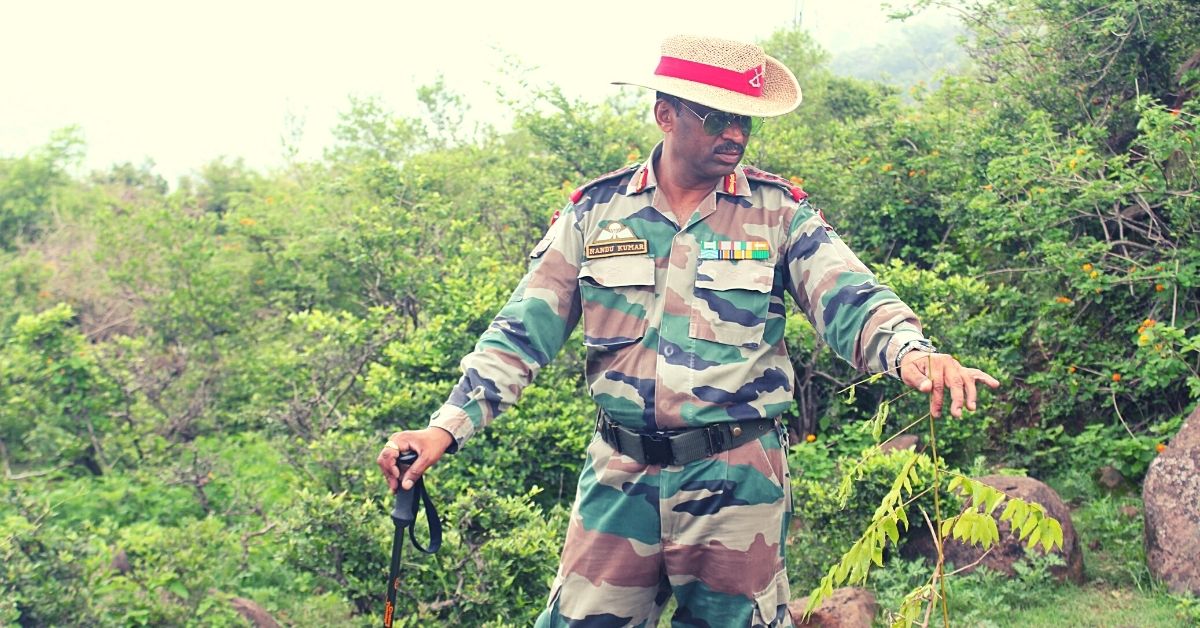How to Build a Rainwater Harvesting System: Retd Colonel Shares Low-Cost Method
Colonel Nandu Kumar’s rainwater harvesting technique uses pipes, a drum, sand, pebbles and a 8-foot deep pit.

Originally from Bengaluru, Retired Col Nandu Kumar was posted in several regions across the country while he was serving in the Indian Territorial Army for over 25 years, where he was well recognised for his bravery. But, in his own way, this patriot continues to serve the nation even to this day, thanks to his water-saving ideas.
His innovative Rain Water Harvesting (RWH) technique has helped close to 400 spots in and around the Jammu valley and Uttarakhand exponentially recharge otherwise depleting groundwater tables while reducing the risk of floods.
“I realised the inevitable problem of flooding while serving as the commanding officer in Pithoragarh and Samba district in Uttarakhand and Jammu respectively. The ironic part was these same flooded regions also faced water scarcity and groundwater depletion, as a result of which the survival rates of plants were very low. With an effective RWH structure, we were able to solve all these problems in one go,” Col Kumar, who commanded the 129 Infantry Battalion (TA) Ecological JAKLI in 2019 tells The Better India.

For each structure, he spent close to Rs 1000, that can save up to 5,000 litres of water per hour.
He spent the money on purchasing drums and pipe fittings. The labour costs were zero as his men helped in digging the pits and and utilised sand and pebbles locally available in abundance in the hilly areas.
However, for someone planning to build the structure in urban areas, he/she will have to spend extra on labour and purchasing sand/pebbles. Col Kumar, who presently lives in Bengaluru, points out that the total cost, which is a one-time investment can go up to Rs 5000 depending upon the size.
Steps For the Cost-Effective Solution

Materials required: a plastic drum, sufficient pipe, pebbles, sand, and a gully trap.
- Dig a pit in the ground to a depth of 8-10 feet, with a diameter of 4 feet
- Make tiny holes in the bottom and around the drum
- Make the pipe fittings and add the gully trap to collect solid waste (as shown in the image). Insert the pipe from the top in the drum in a way that 2 inches of the pipe peep out of the ground, to let the water penetrate
- Make the first layer in the ground with pebbles and sand and place the drum on top
- Fill the space around the drum with pebbles up to the brim.
- Cover the drum with one feet of mud and place an iron grill to prevent any kind of damage.
This structure was constructed by Col Kumar and his battalion in four areas of Pithoragarh and Samba, “A visible change was noted in the campus of our Samba sector where our lawn would turn yellow due to humidity and the staff would have to water it every day. A few months after we installed the structure, he started watering the lawn on alternate days.”
Seeing the exemplary results, other battalions learnt Col Kumar’s method and replicated it in their respective regions Almora and Pithoragarh.
“As far as my knowledge is concerned, at least 400 such structures were created during my tenure from 2014-2019,” he says.
For those wanting to install the same model, he says a minimum area, about 3×3 foot in diameter, is necessary.
“Dig a 3.5×3.5-foot pit that is 8 feet deep. Sandwich the drum between the sand and pebbles. Make the perforated hole and connect your rooftop pipes with it. This hole will allow thousands of litres of rainwater to percolate underground. This will recharge the groundwater tables,” Col Kumar explains.
Besides the RWH structures, Col Kumar was also instrumental in creating other water 4000 conservation systems like bunds and canals during his tenure.
The eco-warrior is also credited for organising a massive plantation drive in 2015 that secured a place in the Limca Book of records. The force along with the participation of the community and local panchayats planted one lakh saplings (15 varieties) in just 19 minutes around the Almora and Pithoragarh districts of the Kumaon region.
“Such a noble cause can only be accomplished if it is supported by one and all in the society. We intend to involve the social fabric of Pithoragarh so that they develop their concern towards nature and the ecological system,” he said.
All the images are sourced from Retd Col Nandu Kumar
(Edited by Vinayak Hegde)
If you found our stories insightful, informative, or even just enjoyable, we invite you to consider making a voluntary payment to support the work we do at The Better India. Your contribution helps us continue producing quality content that educates, inspires, and drives positive change.
Choose one of the payment options below for your contribution-
By paying for the stories you value, you directly contribute to sustaining our efforts focused on making a difference in the world. Together, let’s ensure that impactful stories continue to be told and shared, enriching lives and communities alike.
Thank you for your support. Here are some frequently asked questions you might find helpful to know why you are contributing?


This story made me
-
97
-
121
-
89
-
167











